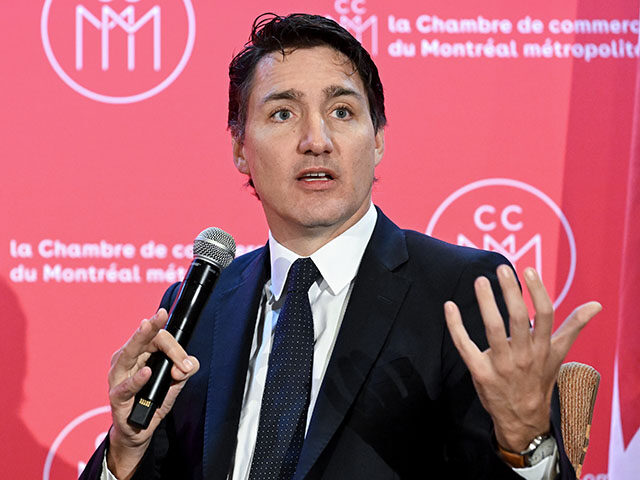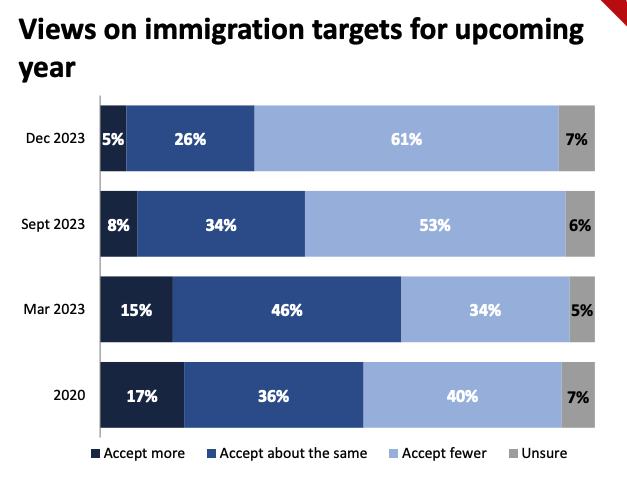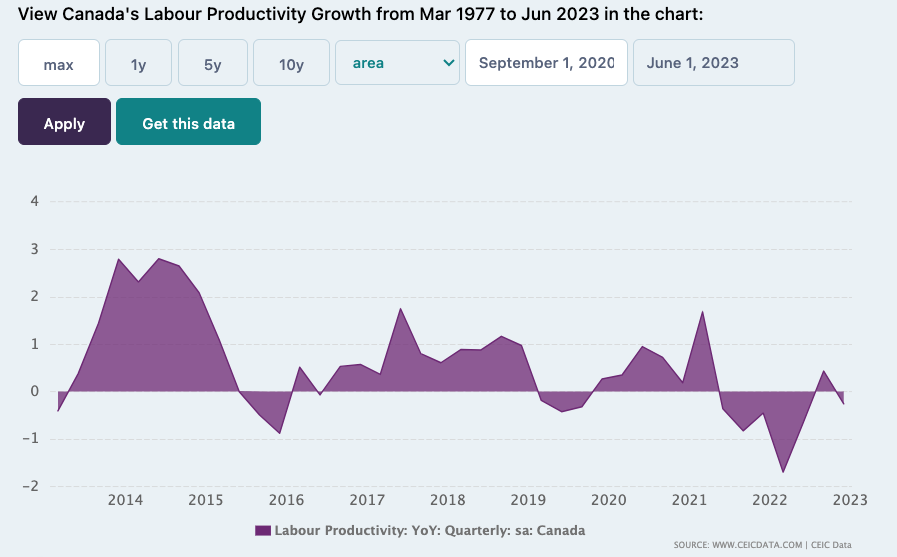Canada’s top bankers are blasting Prime Minister Justin Trudeau’s migration strategy for wrecking the nation’s economy — and for helping Canada’s political populists.
“We’ve screwed it up,” said Beata Caranci, the Chief Economist at Canada’s TD Bank Group. “We took what we thought is a good thing [high immigration] and thought, “Well, if it’s a good thing, then more is a better thing, and now we’re realizing, no, that’s not the case.”
Canadian CEOs are hiring Trudeau’s imported workers instead of investing in the workplace machinery that helps Canadians become more productive and wealthier, said Jean-Francois Perrault, Senior Vice-President & Chief Economist at Scotiabank. “We made it too easy for businesses to hire [foreign] folks,” instead of making it easier for Canadian investors and workers to grow high-tech companies, he said.
“They lost control on immigration policy,” said Stefane Marion, the Chief Economist and Strategist at the National Bank of Canada.
“We have to start thinking more intelligently” to fix the problem, said Caranci, adding:
If they don’t start to show some courage on putting [lower] target numbers [for immigration], and making sure the numbers match up to the housing supply, they run the risk that we start to end up with populist views and we know what that looks like south of the border.
The bankers spoke at a 2024 forecast organized by the Economic Club of Canada in Toronto.
The December 27 event came as Canadians are revolting against Justin Trudeau’s immigration policy, which force-fed the nation of 39 million with more than 1.25 million migrants in 2023.
Trudeau’s rapid population stimulus has spiked inflation, held down wages, driven up housing prices, created a homeless population, reduced the number of Canadians able to have kids, and suppressed the productivity improvements that allow bigger wages and higher living standards. Those problems have stopped economic growth — so minimizing the banks’ ability to make profitable loans and investments.
But Trudeau’s economic disaster delivered a post-2015 boon to investors who profited by skimming shares from the additional economic activity from Canada’s exploding population of workers, consumers, and renters.
Recent polls show the dramatic turnaround in Canadian views, according to a January 13, hand-wringing editorial in the nation’s establishment newspaper, the Globe and Mail:
Less than a year ago, polling by Nanos Research showed 61 per cent of Canadians thought that immigration levels should either be increased or stay the same, in keeping with a decades-old consensus that welcomes newcomers to this country.Public opinion has inverted, according to Nanos. In December, 61 per cent of Canadians said immigration levels should be reduced, with just 34 per cent still believing that Canada should maintain or increase the number of newcomers.
Trudeau’s government in Ottowa “needs to change course, quickly,” the editorial said.
However, Canada’s primary conservative party — the Progressive Conservative Party of Canada — is also a cheerleader for more immigration.
For example, party leader Pierre Poilievre is promising to not make housing shortages worse. “We need to make a link between the number of homes built and the number of people we invite as new Canadians,” he said in January. He is also promising more construction as he dangles more migration to win votes from Canada’s growing population of India-born Sikhs.
The leading pr0-Canadian party, The People’s Party of Canada, is getting about 5 percent polling support. But if the party can reach 10 percent, it will likely win a critical role in Canada’s parliamentary system.
Canadians are struggling to afford housing and groceries. The last thing we need is direct flights bringing more and more people into Canada.
Enough is enough — time to end mass immigration! pic.twitter.com/lqtliueLmT
— Maxime Bernier (@MaximeBernier) January 17, 2024
The Canadian Experiment
Canada’s experiment with migration is important because citizens of many nations — the United States, Australia, the United Kingdom, Ireland, and others — are being thrown into the same elite-created whirlpool.
For example, Ireland’s leaders and businesses are pushing to expand their nation’s population with immigrants from Ukraine, the Middle East, and Asia. The inevitable result is a massive windfall for landowners as the imported population inflates housing prices, lowers inflation-adjusted wages, and spikes public opposition:
Minister for Integration Roderic O'Gorman admitted that the system for housing asylum seekers will remain under pressure in the short term | Read more: https://t.co/2OJkItWP4Y pic.twitter.com/qftzbgFjQ3
— RTÉ News (@rtenews) January 16, 2024
“I think the social contract has been completely ruptured for younger generations,” Rory Hearne, an associate professor in social policy at Maynooth University, told the New York Times for a January 15 article.
Hearne, like many other progressives, did not blame the disaster on the Irish government’s pro-migration alliance with the nation’s real estate investors. Instead, he blamed the Irish government’s failure to undermine the investors by building government housing before imposing the diverse migrants on ordinary Irish. “The housing policy created this housing crisis,” he insisted.
In the United States, President Joe Biden’s pro-migration border chief is also trying to emulate Canada‘s low-wage, expensive-housing policy. For example, in May 2023, border chief Alejandro Mayorkas told CBS:
I spoke with my counterparts in Canada, in Spain. Their [immigration] systems are designed to match their [employers’] labor needs with a potential supply of personnel who want to work and build a better life. We are stuck in an antiquated system that can’t match the two. It is just so incredibly sad.
Since early 2021, Mayorkas has cut many new pathways through the nation’s borders for at least 5 million economic migrants. The expanded migration cut Americans’ wages and drove up Americans’ housing prices, so shifting vast wealth from ordinary Americans to investors on Wall Street.
Mayorkas’ inflow has also created a political crisis for Biden’s 2024 campaign. Biden’s bad polls are forcing Democrats to beg Republicans for additional money to help house and hide migrants in the run-up to the November 2024 election.
Mayorkas has largely dodged questions about the pocketbook cost of his migration-based labor strategy, largely because Hill legislators and the media do not want to talk about migration as an economic strategy.
The Canadian Disaster
The Canadian bankers, however, were more willing to argue against Trudeau’s policy of extracting migrant workers, consumers, and renters from poor countries.
Immigration helped create the housing problem, but “the government is moving fairly slowly on this,” said Avery Shenfeld, managing director & Chief Economist at ICBC Capital Markets. “The numbers just don’t add up.”
“Hopefully, we’ll see change at some point,” said Wright.
“I’m hoping that whoever is the government — current and future — really starts to tackle this head-on,” said Caranci. “We just need someone to take the lead on this [cutting immigration] at the end of the day.”
Watch the video here:
Throughout the 89-minute event, the establishment bankers unloaded on Trudeau’s migration policy.
When asked about how Trudeau’s government has gone wrong, Caranci volunteered:
I can go back to the immigration argument. If another government would take a more, you know, thoughtful approach of making sure we have proper alignment of social structure to the number of [immigrant] people and would have the policy in place to implement it — even if it’s slightly unpopular among some groups — [because] we have to take those steps for all Canadians. So that it’s something that could happen in this government or another government.
“I’m frankly surprised we’ve screwed it up because we sit in such a privileged position in Canada,” said Caranci, adding:
We don’t have 2 million people crossing our borders like they do in the U.S … We’re not dealing with this migrant flow across the continent like other countries are having to deal with …. We design our own policy. We put it in place, we implement it. We still screwed it up.
“We have the most aggressive immigration policy, so yeah, there’s a good chunk of [overall] inflation [from housing spikes] that is due to government,” Shenfeld said. Rising inflation has spiked interest rates, which has reduced demand — and prices — for housing.
Canada is widening its economy with immigration, but is not raising productivity, said Craig Wright, Senior Vice President and Chief Economist at Canada’s largest bank, RBC, or the Royal Bank of Canada.
The economy’s speed limit is labor force growth plus productivity. We’ve heard all about how poor our productivity [growth] is, so our only game in town — our [economic] growth strategy if we had one — would be on labor force: Getting more people in the [labor] market. Last year, all the growth in labor force came from immigration. By 2035-ish, 2035, all the growth in population will come from immigration. So we need to continue to keep immigration very strong … but we have do a better job of tying them in the economy and getting the lift to the productivity side.
But productivity is boosted by high-tech investments, not migration, said Shenfeld:
It would be nice to be able to buy a Canadian phone or, you know, a Canadian tech product, and we don’t do enough of that. It’s those industries that actually generate the big productivity gains … that shows up in productivity numbers because you’re improving the output per worker. We don’t do enough of that.
Canada is losing productivity because it ignores its oil and gas sector, and because there is too little investment in cutting-edge technology, said Marion. “We need to realign, to optimize, what we can do in this country with productivity — we have all the tools to do it,” he added.
“We’ve fallen into a population trap” where the expanding population eats up the money needed to improve technology and productivity, said Marion. He explained:
A population trap is defined where an increase in living standards is no longer possible because you don’t have enough savings to stabilize your capital to labor ratio. For the first time in Canadian history in 2023, our capital/labor ratio declined. That’s a population trap. Historically, it’s normally associated with emerging markets [such as Africa]. We’re the only OECD country that’s ever experienced this … [and] it is undermining living standards.
"The reality is nobody can afford life right now"
"I can't even afford my groceries"
"I'm working 40 hours a week and I'm on a single income"
"Nobody knows what to do"
"We're going into further debt"
"More and more people are immigrating here"
🚨🚨🚨 pic.twitter.com/InsKPuY5XM
— Wall Street Silver (@WallStreetSilv) January 16, 2024
If the government wants to raise productivity, it should accept labor shortages, Caranci said. Government should “be careful of having an ear [for] the sympathies of corporations who are complaining that they’re having trouble finding workers,” she said, adding:
If you look at what has happened in retail and accomodation, for example, two sectors that have had a lot of difficulty during the pandemic. [They] wanted to argue to bring in a lot of low-skilled workers. Well, those are two sectors that have been releasing workers for the last three to four months consistently. So if you tailor a policy to the moment, it makes no sense because [the economy is] cyclical and those those [economic] markers start to move on you.
…
Of course, there’s going to be [labor] shortages in construction and other areas. Construction, by the way, is one of the areas that has the worst productivity, like people still use hammers and nails … So I’ll just say like, there can be a lot of [productivity] improvements there.
Migration is pushing Canadians into smaller living spaces, said Wright: “People are getting pushed out of the housing market and into the rental market.” Multiple studies show that birth rates decline when couples cannot buy houses.
“Canada’s birth rate has dropped off a cliff (and it’s likely because nobody can afford housing),” Canada’s National Post newspaper noted in October 2023.
What does the next ten years look like for Canadian millennials, with inflation and mass immigration?
Not good. pic.twitter.com/TAOokp0iV6
— Maxime Bernier (@MaximeBernier) January 16, 2024
Programs that import supposedly temporary migrants also worsen housing shortages and inflation, said Shenfeld. “Rents are very expensive … That’s tied to rapid immigration, not just permanent residents, but hundreds of thousands of students every year — temporary foreign workers,” he said.
The huge inflow of supposedly temporary students and workers — regardless of skills — is driven by the economic interests of colleges and universities, said Shenfeld. “It’s just really a tuition-making machine … I do think we have to dial this down.”
If the government does not have the nerve to correct its failure, Canada may see a populist upsurge, Caranci warned:
We need courage on immigration policy … I think Canadians are very, very open to immigration. This is not a discussion about being anti-immigration. This is a discussion about the numbers and the right numbers. And if they don’t start to show some courage on putting [lower] target numbers, and making sure the numbers match up to the housing supply, they run the risk that we start to end up with populist views and we know what that looks like south of the border. So they really need to start thinking through what is the appropriate amount of foreign [workers] to bring in.
“So we have to start thinking more intelligently and have a bit more courage on what we’re doing… There actually needs to be some math behind what we’re doing and there’s not [now],” Caranci noted.
“Even if it’s slightly unpopular among some groups [because] we have to take those steps for all Canadians,” Caranci concluded.



COMMENTS
Please let us know if you're having issues with commenting.